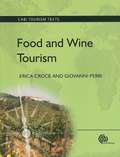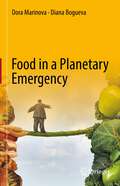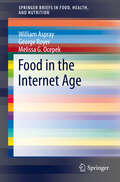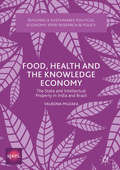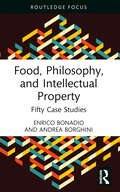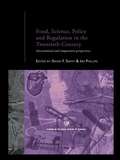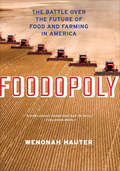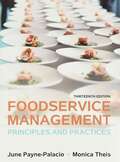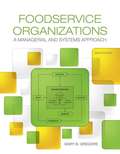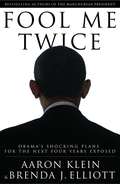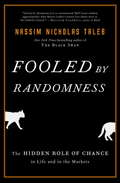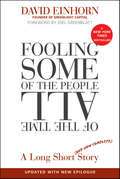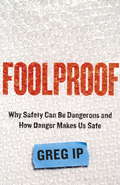- Table View
- List View
Food and Wine Tourism: Integrating Food, Travel and Territory
by Giovanni Perri Erica CroceIn this cultural, thematic, integrated and sustainable form of tourism, the spirit of a place can be sampled on a plate and experienced directly through tours and visits to producers. If food and wine tourism is well planned, managed and controlled, it can become a real economic resource. This text explores how food producing regions present themselves to tourists experiencing the culture, history and ambience of a location through the food and wine it produces. The book takes a practical approach, discussing how to establish a food-related tourism destination, how to evolve from purely a food producer to a tourism operator. It also covers management practices such as producing marketing material, and considerations of sustainability and quality assessment. This book is adapted with an international focus from Croce, E. and Perri, G. (2008) "Il turismo enogastronomico. Progettare, gestire, vivere l'integrazione tra cibo, viaggio, territorio", FrancoAngeli s.r.l., Milano, Italy
Food and Wine Tourism: Integrating Food, Travel and Terroir (CABI Tourism Texts)
by Giovanni Perri Erica CroceThis established textbook explores how regions, and food industry, travel and hospitality companies present themselves to tourists experiencing the culture, history and ambience of a location through the food and wine it produces. It provides practical suggestions and guidelines for establishing a food-related tourism destination and business, discussing the environment, understanding the food tourist, supply issues, tours and tasting sessions, themed itineraries, planning and developing the tourist product, marketing and best practice strategies. It also includes numerous case studies from around the world and plentiful pedagogical features to aid student learning. The second edition: - Contains updated chapters throughout, to form a complete and current overview of food and wine tourism. - Reviews new emerging destinations, and food and wine tourism from a business perspective. - Includes new global case studies discussing aspects such as transforming an Indian area into a wine-producing region, promoting a destination through a social media campaign, chocolate tourism in Belize, planning an international food fair, and making San Francisco a food capital. - Presents successful international professionals' experiences and tips, catching trends and setting the tourism phenomenon in an even more international context. If food and wine tourism is well planned, managed and controlled, it can become a real economic resource. Suitable for students in tourism and leisure subjects, the practical application provided in this book also makes it an ideal resource for those operating in the food and wine sector.
Food for Degrowth: Perspectives and Practices (Routledge Environmental Humanities)
by Anitra Nelson and Ferne EdwardsThis collection breaks new ground by investigating applications of degrowth in a range of geographic, practical and theoretical contexts along the food chain. Degrowth challenges growth and advocates for everyday practices that limit socio-metabolic energy and material flows within planetary constraints. As such, the editors intend to map possibilities for food for degrowth to become established as a field of studies. International contributors offer a range of examples and possibilities to develop more sustainable, localised, resilient and healthy food systems using degrowth principles of sufficiency, frugal abundance, security, autonomy and conviviality. Chapters are clustered in parts that critically examine food for degrowth in spheres of the household, collectives, networks, and narratives of broader activism and discourses. Themes include broadening and deepening concepts of care in food provisioning and social contexts; critically applying appropriate technologies; appreciating and integrating Indigenous perspectives; challenging notions of 'waste', 'circular economies' and commodification; and addressing the ever-present impacts of market logic framed by growth. This book will be of greatest interest to students and scholars of critical food studies, sustainability studies, urban political ecology, geography, environmental studies such as environmental sociology, anthropology, ethnography, ecological economics and urban design and planning.
Food for the Few: Neoliberal Globalism and Biotechnology in Latin America
by Gerardo OteroRecent decades have seen tremendous changes in Latin America's agricultural sector, resulting from a broad program of liberalization instigated under pressure from the United States, the IMF, and the World Bank. <P><P>Tariffs have been lifted, agricultural markets have been opened and privatized, land reform policies have been restricted or eliminated, and the perspective has shifted radically toward exportation rather than toward the goal of feeding local citizens. Examining the impact of these transformations, the contributors to Food for the Few: Neoliberal Globalism and Biotechnology in Latin America paint a somber portrait, describing local peasant farmers who have been made responsible for protecting impossibly vast areas of biodiversity, or are forced to specialize in one genetically modified crop, or who become low-wage workers within a capitalized farm complex. Using dozens of examples such as these, the deleterious consequences are surveyed from the perspectives of experts in diverse fields, including anthropology, economics, geography, political science, and sociology. From Kathy McAfee's "Exporting Crop Biotechnology: The Myth of Molecular Miracles," to Liz Fitting's "Importing Corn, Exporting Labor: The Neoliberal Corn Regime, GMOs, and the Erosion of Mexican Biodiversity," Food for the Few balances disturbing findings with hopeful assessments of emerging grassroots alternatives. Surveying not only the Latin American conditions that led to bankruptcy for countless farmers but also the North's practices, such as the heavy subsidies implemented to protect North American farmers, these essays represent a comprehensive, keenly informed response to a pivotal global crisis.
Food in a Planetary Emergency
by Dora Marinova Diana BoguevaThis book Food in a Planetary Emergency is a timely overview of the current food systems and the required transformations to respond to the challenges of climate change, population pressures, biodiversity loss and use of natural resources, such as soils, water and phosphorus. This book takes a planetary health perspective which explores the links between natural systems and human wellbeing implying that there is need for united actions to achieve important environmental and population health co-benefits.This book outlines that the foundation of planetary health is sustainability. It addresses environment and climate change emergency as a global agenda, however, emphasises the urgency of the sustainability perspective which integrates a wide spectrum of issues that require integrated solutions to offer better prospects for humanity. This book drives this argument further through the global Sustainable Development Goals (SDGs) where food is not just SDG2 but transcends all 17 goals.This book tackles the problems of food production and consumption at a global, industry and individual level linking it to topics related to the natural environment, climate change, waste, marketing, new ways of producing food and providing alternative proteins, mitigating non-communicable diseases, flexitarianism and the role of Generation Z in the emerging dietary choices.This book benefits readers with understanding the importance and intricacy of their dietary choices at a point in time when our planet is facing an emergency triggered by long-term dependence on fossil fuels and artificial fertilisers but also by the ways we have provided food. However, this book also delivers the message that safeguarding and sustaining planetary health is possible.
Food in the Internet Age
by William Aspray George Royer Melissa G. OcepekThis book examines food in the United States in the age of the Internet. One major theme running through the book is business opportunities and failures, as well as the harms to consumers and traditional brick-and-mortar companies that occurred as entrepreneurs tried to take advantage of the Internet to create online companies related to food. The other major theme is the concept of trust online and different models used by different companies to make their web presence seem trustworthy. The book describes a number of major food companies, including AllRecipes, Betty Crocker, Cook's Illustrated, Epicurious, Groupon, OpenTable, and Yelp. The book draws on business history, food studies, and information studies for its approach.
Food, Energy and the Creation of Industriousness
by Craig Muldrew"Until the widespread harnessing of machine energy, food was the energy which fuelled the economy. In this groundbreaking study of agricultural labourers' diet and material standard of living Craig Muldrew uses new empirical research to present a much fuller account of the interrelationship between consumption, living standards and work in the early modern English economy than has previously existed. The book integrates labourers into a study of the wider economy and engages with the history of food as an energy source and its importance to working life, the social complexity of family earnings and the concept of the 'industrious revolution'. It argues that 'industriousness' was as much the result of ideology and labour markets as labourers' household consumption. Linking this with ideas about the social order of early modern England the author demonstrates that bread, beer and meat were the petrol of this world and a springboard for economic change"--
Food, Health and the Knowledge Economy: The State and Intellectual Property in India and Brazil (Building a Sustainable Political Economy: SPERI Research & Policy)
by Valbona MuzakaThis book opens a window into how two ambitious countries – India and Brazil – are seeking to become knowledge powers in the 21st century. As the knowledge economy became the preferred way of conceptualising the economy and its future direction, in the more economically-advanced countries, our search for understanding also followed the same direction. This generated a body of work that has neglected countries that, like India and Brazil, are attempting to make the leap into knowledge economies. Muzaka explores these motivations and the ways in which they have inspired a number of institutional reforms in India and Brazil. The author offers an investigation of the role the state in shaping the respective intellectual property systems pertaining to the pharmaceutical and agro-biotechnology sectors and the multiple social conflicts that have unfolded as a result.
Food, Labor, And Beverage Cost Control: A Concise Guide
by Edward E. SandersFood, Labor, and Beverage Cost Control: A Concise Guide
Food, Philosophy, and Intellectual Property: Fifty Case Studies
by Andrea Borghini Enrico BonadioThis is a book about food, philosophy, and intellectual property rights.Taken separately, these are three well-known subjects, but it is uncommon to consider them together. The book comprises 50 case studies, organized around eight themes: images; genericity and descriptiveness; language traps; procedures; menus, recipes, and creativity; boundaries; biotech; and empowerment. The introductory chapter frames the selection of cases and encourages readers to look beyond them, envisaging new lenses to look at food vis-à-vis intellectual property. The terrain encompassed is wide-ranging and reaches out to fine-grained aspects of food products, recipes, and cooking. Conceived for a wide scope of readers, the volume ultimately interrogates the links between food and cultural identity, bringing to the fore the ethical, political, and aesthetic worth of culinary arts and gastronomic experiences.This accessible book will be of value to scholars, students, practitioners, and others with interests in the areas of intellectual property, food law, and food studies.
Food, Science, Policy and Regulation in the Twentieth Century: International and Comparative Perspectives (Routledge Studies in the Social History of Medicine #10)
by Jim Phillips David F. SmithThis highly topical book offers a comprehensive study of the interaction of food, politics and science over the last hundred years. A range of important case studies, from pasteurisation in Britain to the E coli outbreak offers new material for those interested in science policy and the role of expertise in modern political culture.
Food, Senses and the City (Routledge Studies in Food, Society and the Environment)
by Ferne Edwards Roos Gerritsen Grit WesserThis work explores diverse cultural understandings of food practices in cities through the senses, drawing on case studies in the Americas, Asia, Australia, and Europe. The volume includes the senses within the popular field of urban food studies to explore new understandings of how people live in cities and how we can understand cities through food. It reveals how the senses can provide unique insight into how the city and its dwellers are being reshaped and understood. Recognising cities as diverse and dynamic places, the book provides a wide range of case studies from food production to preparation and mediatisation through to consumption. These relationships are interrogated through themes of belonging and homemaking to discuss how food, memory, and materiality connect and disrupt past, present, and future imaginaries. As cities become larger, busier, and more crowded, this volume contributes to actual and potential ways that the senses can generate new understandings of how people live together in cities. This book will be of great interest to students and scholars of critical food studies, urban studies, and socio-cultural anthropology.
Food-Energy-Water Nexus Resilience and Sustainable Development: Decision-Making Methods, Planning, and Trade-Off Analysis
by Behnam Mohammadi-Ivatloo Somayeh AsadiThis book presents readers with an integrated modeling approach for analyzing and understanding the interconnection of water, energy, and food resources and discusses the relationship between resilience and sustainability of the food- energy –water (FEW) system. Authors provide novel frameworks, models, and algorithms designed to balance the theoretical and applicative aspects of each chapter. The book covers an integrated modeling approach for FEW systems along with developed methods, codes, and planning tools for designing interdependent energy, water and food systems. In-depth chapters discuss the impact of renewable energy resources in FEW systems, sustainable design and operation, net zero energy buildings, and challenges and opportunities of the FEW nexus in the sustainable development of different countries. This book is useful for graduate students, researchers, and engineers seeking to understand how sustainable FEW systems contribute to the resilience of these systems and help policy and design makers allocate and prioritize resources in an integrated manner across the food, energy, and water sectors.
Food: Governance Challenges And Opportunities (Resources)
by Jennifer ClappWe all need food to survive, and forty percent of the world’s population relies on agriculture for their livelihood. Yet control over food is concentrated in relatively few hands. Turmoil in the world food economy in recent decades has highlighted a number of vulnerabilities and contradictions inherent in the way we currently organize this vital sector. Extremes of both undernourishment and overnourishment affect a significant proportion of humanity. And attempts to increase production through the spread of an industrial model of agriculture has resulted in serious ecological consequences. The fully revised and expanded third edition of this popular book explores how the rise of industrial agriculture, corporate control, inequitable agricultural trade rules, and the financialization of food have each enabled powerful actors to gain fundamental influence over the practices that dominate the world food economy and result in uneven consequences for both people and planet. A variety of movements have emerged that are making important progress in establishing alternative food systems, but, as Clapp’s penetrating analysis ably shows, significant challenges remain.
FoodFight: The Citizen's Guide to a Food and Farm Bill
by Daniel ImhoffThe Farm Bill is perhaps the single most significant land use legislation enacted in the United States, yet many citizens remain unaware of its power and scope. With subsidies ballooning toward $25 billion dollars per year, the Farm Bill largely dictates who grows what crops, on what acreage, and under what conditions--all with major impacts on the country's rural economies, health and nutrition, national security, and biodiversity. As debate and wrangling over the 2007 Farm Bill intensifies, FoodFight offers a highly informative and visually engaging overview of legislation that literally shapes our food system, our bodies, and our future.
Foodopoly: The Battle Over the Future of Food and Farming in America
by Wenonah Hauter&“A meticulously researched tour de force&” on politics, big agriculture, and the need to go beyond farmers&’ markets to find fixes (Publishers Weekly). Wenonah Hauter owns an organic family farm that provides healthy vegetables to hundreds of families as part of the Community Supported Agriculture (CSA) movement. Yet, as a leading healthy-food advocate, Hauter believes that the local food movement is not enough to solve America&’s food crisis and the public health debacle it has created. In Foodopoly, she takes aim at the real culprit: the control of food production by a handful of large corporations—backed by political clout—that prevents farmers from raising healthy crops and limits the choices people can make in the grocery store. Blending history, reporting, and a deep understanding of farming and food production, Foodopoly is a shocking, revealing account of the business behind the meat, vegetables, grains, and milk most Americans eat every day, including some of our favorite and most respected organic and health-conscious brands. Hauter also pulls the curtain back from the little-understood but vital realm of agricultural policy, showing how it has been hijacked by lobbyists, driving out independent farmers and food processors in favor of the likes of Cargill, Tyson, Kraft, and ConAgra. Foodopoly shows how the impacts ripple far and wide, from economic stagnation in rural communities to famines overseas, and argues that solving this crisis will require a complete structural shift—a change that is about politics, not just personal choice.
Foods of Non-Animal Origin
by Arpan Bhagat Giorgia Caruso Maria Micali Salvatore ParisiThis Brief discusses aspects of the increasingly complex production of legal and reliable food products of non-animal origin. It introduces to the Food Safety Modernization Act (FSMA) in the USA (from January 2011), which requires the food industry to follow risk-based approaches with stronger self-regulation of food safety through measures such as the foreign supplier verification programs (FSVPs). The Brief addresses important chemical hazards of vegetable products: their peculiar microbial ecology, that can become responsible for the occurrence of specific foodborne disease outbreaks, and the chemistry of the involved neurotoxins and other dangerous molecules, that can potentially lead to lethal pathological reactions. Finally, the Brief also critically discusses the technology of ready-to-eat vegetable products and chemical and physical modifications used for packed products (respiration of vegetables, colorimetric modifications, etc. ).
Foodservice Management: Principles And Practices
by June Payne-Palacio Monica TheisFor courses in foodservice management or administration; hospitality management; quantity food production and/or purchasing; foodservice accounting/financial management; menu planning; foodservice marketing/merchandising, or related topics Foodservice Operations for Today’s College Students Authored by leading industry experts with years of teaching experience, the Thirteenth Edition of Foodservice Management: Principles and Practices offers a comprehensive, current, and practical overview of foodservice operations and business principles. Covering topics like food safety, human resources, finance, equipment, design, marketing, and filled with real-life case studies, this text gives college students a deep understanding of the issues they will face in any type of foodservice operation. Rich with graphics and photos, its visually appealing design is organized for maximum student engagement and understanding. This edition has been updated to reflect new trends in sustainability and food safety issues.
Foodservice Organizations: A Managerial And Systems Approach
by Mary B. GregoireDetailed discussion concerning how to transform human, material, facility, and operational inputs into outputs of meals, customer satisfaction, employee satisfaction, and financial accountability, the basic principles of the text are applicable to a wide variety of programs.
Fool Me Twice: Obama's Shocking Plans for the Next Four Years Exposed
by Aaron Klein Brenda J. ElliottThis is the game changing book reveals the blueprint for a second term that President Obama and his progressive backers don't want you to know. Months of painstaking research into thousands of documents have enabled investigative journalists and New York Times bestselling authors Aaron Klein and Brenda J. Elliott to expose the secret template for Obama's next four years -- the one actually created by Obama's own top advisers and strategists. Just as Obama concealed the true plans for his initial term behind rhetoric of ending partisan differences and cutting the Federal deficit, Obama's re-election theme of creating jobs conceals more than it reveals about his real agenda for a second term. All the main areas of domestic policy are covered -- jobs, wages, health care, immigration overhaul, electoral "reform," national energy policy. Each of the plans exposed seek to permanently remake America into a government-dominated socialist state. Here are just a few samples from dozens upon dozens of specific schemes unveiled herein: Detailed plans to enact single-payer health care legislation controlled by the Federal government regardless of any Supreme Court decision to overturn Obamacare; The recreation of a 21st century version of FDR's Works Progress Administration (WPA) program within the Department of Labor that would oversee a massive new bureaucracy and millions of new Federal jobs; Further gutting of the U. S. military in shocking ways, while using the "savings" for a new "green" stimulus program and the founding of a Federal "green" bank to fund so-called environmentally friendly projects; The vastly reduced resources of the U. S. Armed Forces will be spread even thinner by using them to combat "global warming," fight global poverty, remedy "injustice," bolster the United Nations and step up use of "peacekeeping" deployments; An expansive new amnesty program for illegal aliens linked with a reduction in the capabilities of the U. S. Border Patrol and plans to bring in untold numbers of new immigrants with the removal of caps on H-1B visas and green cards. Fool Me Twice is based on exhaustive research into the coming plans and presidential policies as well as the specific second term recommendations of the major "progressive" groups behind Barack Obama and the Democratic leadership - the organizations that help to craft the legislation and set the political and rhetorical agenda for the president and his allies. While many have general concerns about Obama's second-term ambitions, Fool Me Twice lays bare the devastating details of a second Obama presidency. If he wins re-election in 2012, the America of equal opportunity for all, Constitutionally-limited government, economic freedom and personal liberty will be but a distant memory.
Fool Willing: The Secret Power of Play to Engage Communities in Your Green Organization
by Kathy OppegardImagine what having more advocates could do for environmental organization: more engaged volunteers, more political wins for conservation, more financial support, and more enthusiastic collaborations. The U.S. is fortunate to have people from many different cultures and ethnicities, yet so many of these good folks have not been invited to full participation in the green movement.Fool Willing is a playful, practical guide for welcoming and including all communities at the “green table.” Putting a happy little kid, a salsa-dancing event planner, and Jane Goodall in the same room, Fool Willing would be what they would write together. Its light-hearted voice invites readers to bring playfulness and practicality as they make advances for people and the planet. Author and certified Martha Beck Life Coach, Kathy Oppegard helps people in environmental organizations bring communities into full participation in their organizations and volunteer teams. She has coordinated hundreds of volunteers for multiple events. Dig in and get ready to have more fun and be more effective as you grow your community in your green organization today!
Fooled by Randomness: The Hidden Role of Chance in Life and in the Markets (Incerto #1)
by Nassim Nicholas Taleb"[Taleb is] Wall Street's principal dissident. . . . [Fooled By Randomness] is to conventional Wall Street wisdom approximately what Martin Luther's ninety-nine theses were to the Catholic Church."-Malcolm Gladwell, The New Yorker. Finally in paperback, the word-of-mouth sensation that will change the way you think about the markets and the world. This book is about luck: more precisely how we perceive luck in our personal and professional experiences. Set against the backdrop of the most conspicuous forum in which luck is mistaken for skill--the world of business. Fooled by Randomness is an irreverent, iconoclastic, eye-opening, and endlessly entertaining exploration of one of the least understood forces in all of our lives.
Fooling Some of the People All of the Time
by David EinhornA revealing look at Wall Street, the financial media, and financial regulators by David Einhorn, the President of Greenlight Capital Could 2008's credit crisis have been minimized or even avoided? In 2002, David Einhorn-one of the country's top investors-was asked at a charity investment conference to share his best investment advice. Short sell Allied Capital. At the time, Allied was a leader in the private financing industry. Einhorn claimed Allied was using questionable accounting practices to prop itself up. Sound familiar? At the time of the original version of Fooling Some of the People All of the Time: A Long Short Story the outcome of his advice was unknown. Now, the story is complete and we know Einhorn was right. In 2008, Einhorn advised the same conference to short sell Lehman Brothers. And had the market been more open to his warnings, yes, the market meltdown might have been avoided, or at least minimized. Details the gripping battle between Allied Capital and Einhorn's Greenlight Capital Illuminates how questionable company practices are maintained and, at times, even protected by Wall Street Describes the failings of investment banks, analysts, journalists, and government regulators Describes how many parts of the Allied Capital story were replayed in the debate over Lehman Brothers Fooling Some of the People All of the Time is an important call for effective government regulation, free speech, and fair play.
Foolproof: A FINANCIAL TIMES BOOK OF THE YEAR
by Greg IpWhy anti-lock brakes make us drive faster Why saving money can lead to financial crisesHow football helmets make the game more dangerousWhy letting forest fires burn can be safer than putting them outWe have learned a staggering amount about human nature and disaster-yet we are continually unprepared for car crashes, floods, and financial crises. Partly this is because the very success we've had making life safer enables us to take more extreme, different risks. As our cities, transport systems, and financial markets become more interconnected and complex, so does the potential for disaster. How do we stay safe? Should we? What if our attempts are exposing us even more to the very risks we are trying to avoid? What if acceptance of danger ultimately makes us more secure and prosperous? Is there such a thing as foolproof? In this fascinating account of risk-taking and crisis, Greg Ip presents a macro theory of human nature and disaster that explains how we can keep ourselves safe in our increasingly dangerous world.
